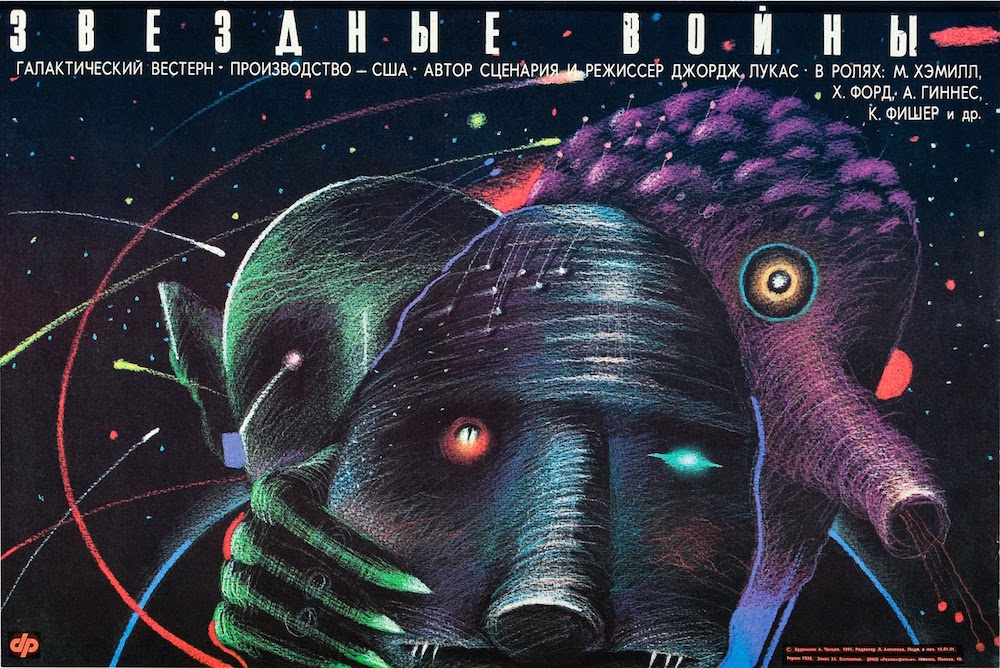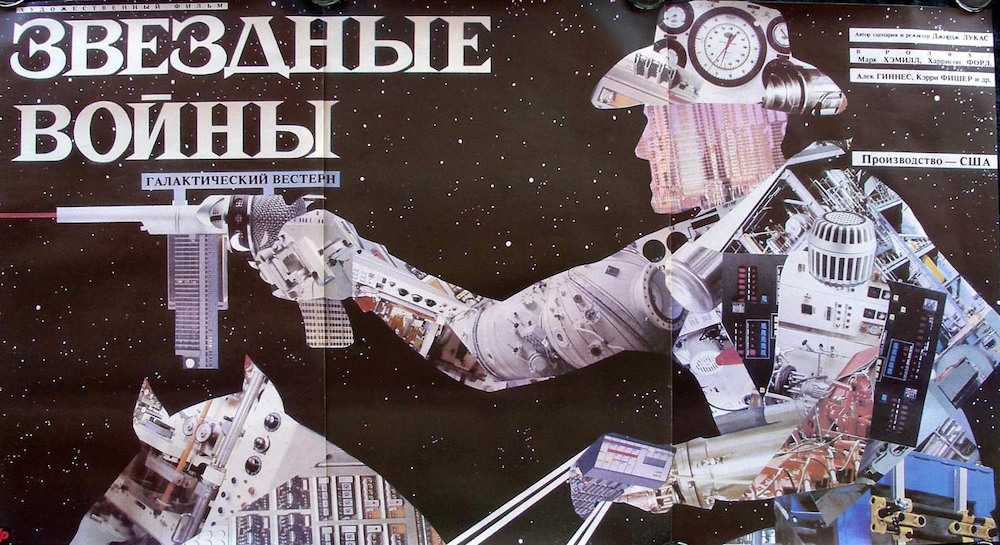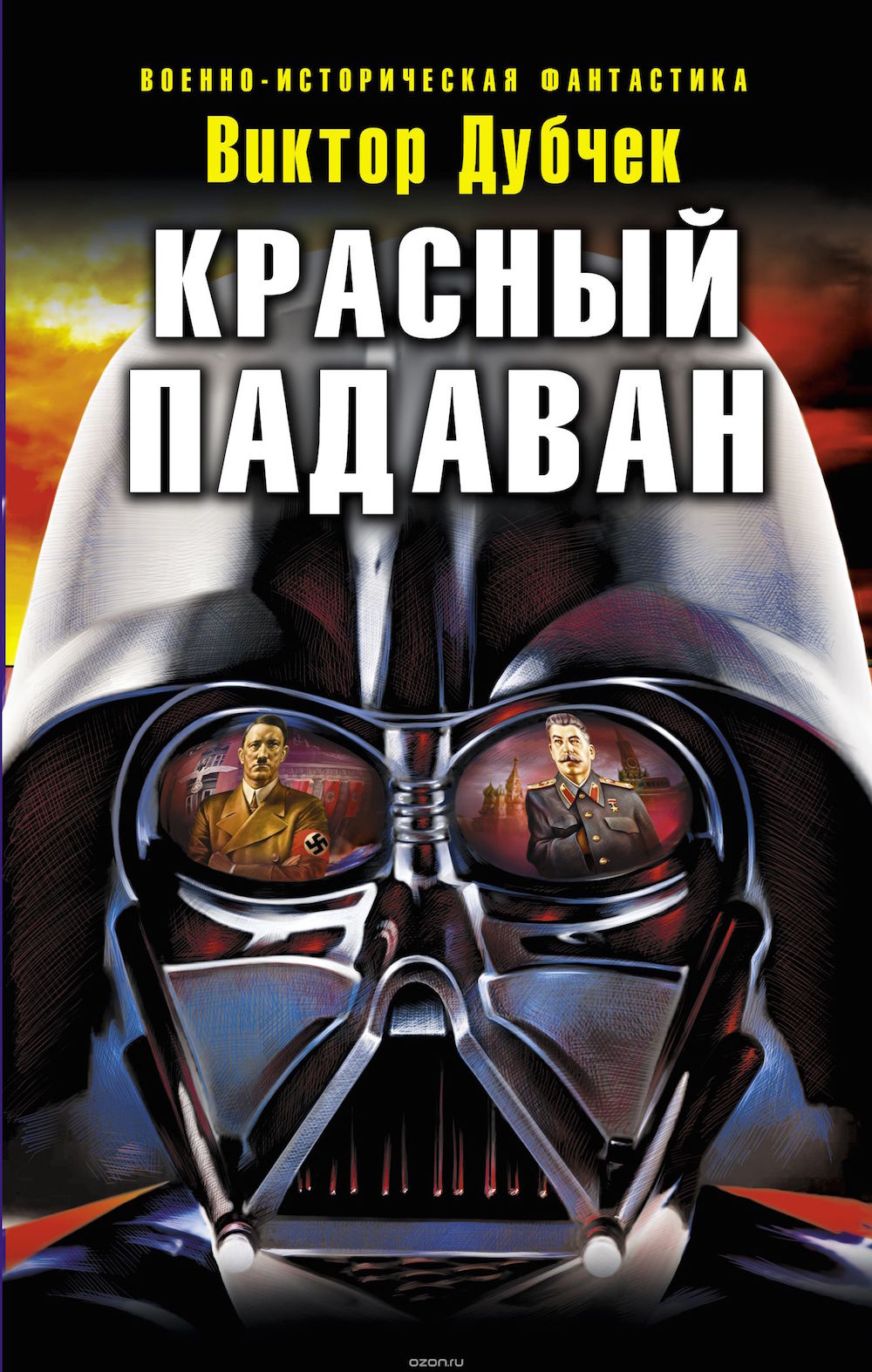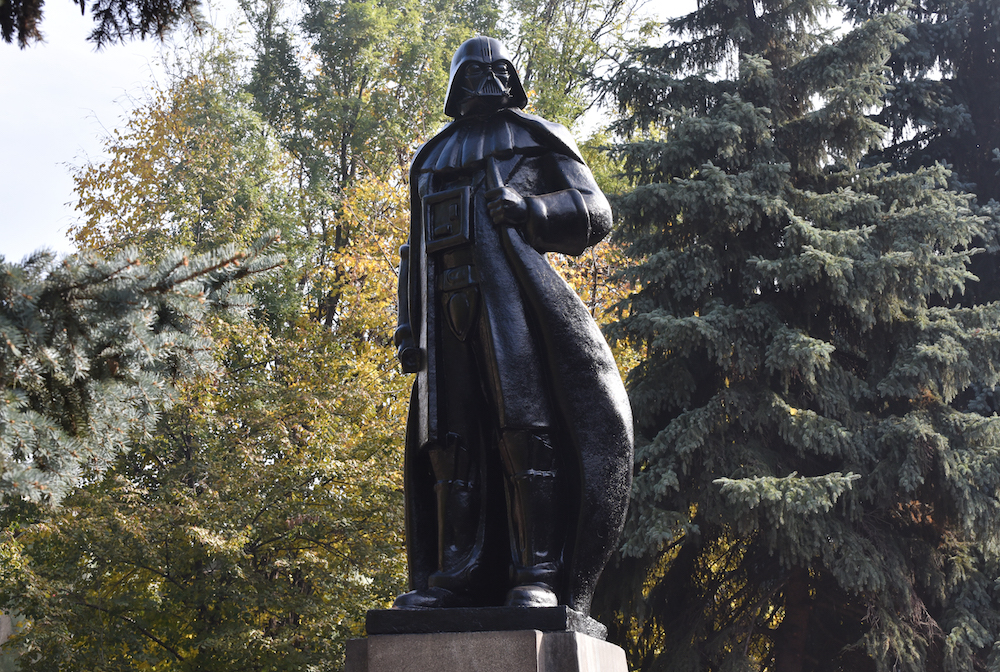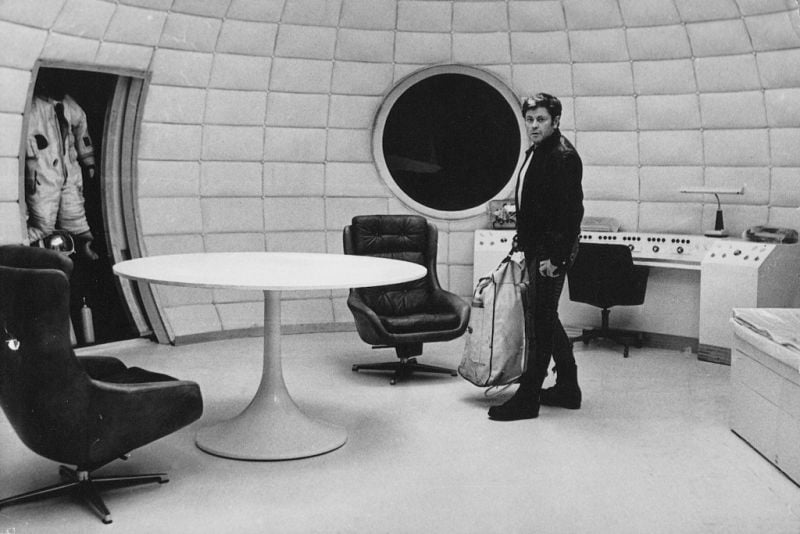Evil empire: why is the post-Soviet world so obsessed with Star Wars?

Star Wars permeates pop culture and politics in Ukraine and Russia today, and yet it wasn't shown in the USSR until 1990. As the long-awaited seventh instalment comes out, Jamie Rann asks why post-Soviet countries are so fascinated with the franchise
Like a rebooted Death Star with fully operational merchandising capabilities, Star Wars: The Force Awakens is looming ominously large on the horizon. Millions of fans, willing to overlook the awkward matter of three clunky prequels, are jumping with anticipation like over-excited Ewoks. But nowhere is Star Wars more important right now than in the former territories of that one-time “Evil Empire”, the Soviet Union, where the Forceful franchise’s mythology is becoming increasingly evident in memes, fan fiction and publicity. As Russia and Ukraine become increasingly dominated by internecine conflict, bombastic rhetoric and political showmanship, Star Wars — with its charismatic bad guys and fairy tale morality — is proving to be a useful way of understanding the world, and of laughing at it.
Star Wars got off to a slow start in the Soviet Union, but from the beginning the swashbuckling space opera was associated not with escapism, but with the blurring of the boundaries between fantasy and reality. Only one instalment of the original trilogy was ever publicly screened in the USSR (fittingly, it was The Empire Strikes Back, in a handful of cinemas in 1988). Instead, Star Wars made its biggest Cold War impact as the nickname for Ronald Reagan’s Strategic Defence Initiative — an impossibly ambitious, largely fictitious space-based anti-missile system. The “Star Wars” tag was first coined by Democrat Ted Kennedy in order to discredit the fantastical scheme, but former actor Reagan knew the power of Hollywood mythmaking, and so was happy to exploit the film’s popularity to bolster his anti-Soviet rhetoric. After the complexities and occasional détentes of the 1970s, American foreign policy turned into a crusade against “the Dark Side”.
Cold War hawks would say that Reagan’s expensive escalation of the arms race was decisive in breaking the USSR. Quite reasonably, this view doesn’t seem to be widespread in Russia, but the clear association of Star Wars, and particularly the Rebel Alliance, with American anti-Sovietism has given the films an ambiguous legacy in the former Soviet Union. If Luke, Han, Leia etc are the Americans, then surely Darth Vader and the massed ranks of anonymous Stormtroopers must be, well, the Russians, or perhaps Soviets, or something in between. For many contemporary liberals, still cherishing their youthful dissidence, this makes the Dark Side a handy metaphor for Soviet tyranny and its Putinist reboot. Hence the recent meme which, in the format of the classic Star Wars opening text scroll, lists the names of Russia’s ruling elite and the year they joined the Communist Party. The title, as you have correctly guessed, is “The Empire Strikes Back”. The notion of Putin as a revenant Commie Vader is also fairly popular among western commentators — the most popular Putin-parody account on English-language Twitter is @DarthPutinKGB.
Vader is, true to the widespread Russian myth of Stalin, firm but fair, “an effective manager”
For the majority of Russians, however, the legacy of the Soviet Union is increasingly seen through the lens not of politics, but nostalgia. And this makes the goodie / baddie division between the Dark Side and the Light somewhat more complicated. There is, for instance, a whole sub-genre on the Russian internet of re-soundtracking YouTube clips: in one notable, but not unique video, you can see Stormtroopers and At-Ats marching, in grainy black and white, to the strains of “The March of the Soviet Tankmen”. Han Solo comes on screen just as the Red Army choir promises to “Be vigilant in seeking out the enemy”. Below the line, the rousing chorus of that song — “When comrade Stalin sends us into battle” — coinciding with shots of Darth Vader, prompts not only teary-eyed reminiscences of the greatness of the Soviet army, but also arguments both about whether Vader and Stalin can really be compared, and whether it’s all a joke.
The answer is, I think, it is and it isn’t. This uneasiness about whether this is all for real or not — which could just as well have been asked of Reagan — also comes to mind when dipping into another fertile pool of Russian-language internet creativity, Stalinist-Sith mash-up fan fiction. In Viktor Dubchek’s Red Padawan trilogy (2011-14) — now available in hard copy! Stop reading now to avoid spoilers! — Vader and a Star Destroyer full of Imperial troops find themselves orbiting earth in 1941 and promptly intervene in WWII on the side of the Soviets. Clear parallels are made in the opening scenes between Stalin and Vader: the latter is, true to the widespread Russian myth of Stalin, firm but fair, “an effective manager”. However, the assistance Uncle Darth gives Uncle Joe comes with considerable strings attached and, since you can’t kid a kidder, Stalin eventually overpowers his Sith counterpart and seizes control of the Empire. Full disclosure: I haven’t read these books cheaply printed cover to cheaply printed cover, but you and I can get something of the tone and political agenda from the final line of the first book: “Stalin liked his new Star Destroyer. Far below him, on the surface of the planet, burned the ruins of Washington.” It’s a beautiful irony, really: America (the real enemy, more even than the Nazis) is destroyed by its own creation, Star Wars.
The assistance Uncle Darth gives Uncle Joe comes with considerable strings attached
On one hand, Dubchek’s Star Wars fandom is evidence of the extent to which Russian and American cultures are inextricable, that the face-off of the 20th century is over. On the other hand, it can be seen as an act of subversion. One of the articles of faith of Russian nationalist conspiracy theorists is the existence of the so-called Dulles Plan — America’s cunning plot to undermine the moral health of the Soviet/Russian people with degenerate pop culture. For nationalists — and if you read Dubchek’s blog, you will have no doubt that he is one — the real defeat of the Dulles Plan may lie not in shutting themselves off from decadent western culture, but in co-opting the trappings of American pop culture, like Star Wars, to promote the Russian nationalist cause, just as Stalin will use Vader’s own light-sabre against him.
The 1990s saw an efflorescence of both anti-American conspiracy theories and of post-modern game-playing with the signifiers of western capitalism, in works like Viktor Pelevin’s famous novel of advertising and spirituality, Generation P. In works like Red Padawan we can see the convergence of these two trends: ironic play with signifiers is used to serve, however remotely, the cause of ideological absolutism. This combination is, of course, very timely, reminiscent as it is of the way in which the current ruling elite uses a pick-and-mix approach to the symbols of the Soviet era (Victory Day parades, anti-fascist slogans, Iosif Kobzon) to justify foreign adventurism and domestic injustice.
“The galaxy is ours” is a nice riff on Yuri Gagarin’s famous “Space is ours” in 1961
The Red Padawan trilogy ends with Stalin, ably assisted by Lavrenty Beria (who, murderous paedophile that he may be, at least has a really Star Wars-y name), defeating Vader and proclaiming: “The galaxy is ours.” That line is a nice riff on Yuri Gagarin’s famous “Space is ours” in 1961, and also on the recent slogan of Russian hurrah-patriotism “Crimea is ours” (Krym nash). In his review of the book, Russian sci-fi legend Sergei Lukyanenko (whose own Manichean fantasy universe, with its Night Watch and Day Watch maintaining the balance between light and dark, surely leans on George Lucas) went so far as to say that Red Padawan, which at first he took for “a lively burlesque balancing on the line between trash and farce”, might “help make our future fantastic”. Lukyanenko’s enthusiasm for such Imperial awakenings is likely linked to the recent war in Ukraine, a subject on which he has been crassly outspoken.
Online, the conflict between Russia and Ukraine is frequently interpreted with recourse to fantasy fiction, and especially Lord of the Rings. While those supportive of Russian intervention glory in a non-existent play on words between “orcs” and “Ukraine”, the liberal intelligentsia in both countries frequently refer to Russia as “Mordor” — an identity alluded to in the recent project to build a real-life “Eye of Sauron” in Moscow. Strangely, state TV channel RT initially welcomed this clearly satirical stunt, which was aborted after criticism from the Russian Orthodox Church, saying “Tolkien fans rejoice! The ‘Eye of Sauron’ now is not just fiction.” And these guys really know their fiction.
Ukrainian Vader gained global recognition for his surprising commitment to participatory democracy
It’s not surprising, perhaps, that LOTR, which was both a hit recent film and compulsory YA reading in the Soviet Union, is the alternative reality of choice for explaining the Ukrainian conflict. But, away from the battlefields in the unpredictable world of Ukrainian politics, Star Wars seems to be gaining ground. Many of mankind’s greatest minds have pondered the question of what Darth Vader does on his time off, but the latest hologram messages coming from Odessa, in the west of Ukraine, suggest he enjoys walking his dog, traditional Ukrainian embroidery and local politics. A recent “Darth at home” photoshoot doing the rounds on the internet is the latest instalment in a barrage of publicity from the charismatic Sith lord’s bid for political power in Ukraine. After campaigns in the last two years to become mayor of Kiev and even president of Ukraine, Ukrainian Vader recently gained global recognition for his surprising commitment to participatory democracy when he was prevented from casting a vote in October’s Odessan mayoral elections. The cape-wearing candidate later slammed his exclusion, insisting on his dual Ukrainian-Galactic Empire citizenship, accusing the authorities of “falsifications” and speaking out in defence of his running mate, “Stepan” Chewbacca, who had been arrested, apparently for a traffic violation.
Campaign ad for Internet Party of Ukraine parliamentary candidate Stepan Chubakka - “A man of his word.” pic.twitter.com/YA5AFDCLVX
— Christopher Miller (@ChristopherJM) October 2, 2014
Unlike joke candidates in America, who accidentally get taken seriously and lead the polls, these absurdist stunts are not only funny, but even have some political substance. Although Vader’s programme draws both on the rich strain of absurdism in Soviet and post-Soviet protests, in the spirit of Novosibirsk’s monstration, and on old-fashioned thigh-slapping gags (Vader promises to deport all the city’s mothers-in-law in Odessa), his political messaging is also clearly intended to appeal to Ukrainian identity. Hence the inclusion of national dish salo on his Kiev mayoral manifesto and this amazing reveal of Darth Vader’s hidden haircut — the traditional Cossack khokhol. What is more, the party of which Vader is the not-so-human face is the entirely legitimate, and fairly serious, Internet Party of Ukraine, the brainchild of Odessan native Dmitry Golubov. (Odessa, we should note, is famed for its rich history of Jewish-inflected humour.)
The most popular point of identification is not the anodyne Luke Skywalker but heavy-breathing antihero Vader
Although Ukrainian Vader’s political orientation seems to be a long way from the Stalinist Sith of Red Padawan, once again we are confronted by the fact that the most popular point of identification in the Star Wars world is not a hero (and especially not the anodyne Luke Skywalker) but heavy-breathing antihero Vader. This is perhaps a product of the central government’s position in the ongoing civil war as the proponents of territorial and federal integrity and order against the “rebels” of Donetsk and Luhansk in the east. While there is still a tongue-in-cheek element to it, Vader has, like President Poroshenko, promised not to give away an inch of Ukrainian land and inveighed against “separatists”. Again, it’s a joke and it’s not a joke (and, ironically, the rhetoric of both Poroshenko and Vader recalls Stalin in the Second World War).
However, Vader’s political alliances also seem to imply the possibility of peaceful co-existence: for his most recent campaign he assembled a ministry of all the talents which includes sometime enemies Princess Leia and Yoda. Furthermore, despite their commitment to the trappings of Ukrainian nationalism, Vader, and the Internet Party of Ukraine, conduct nearly all their business in Russian, the predominant language in Odessa and many other Ukrainian cities. The language question, which has become so contentious in contemporary Ukraine, was nicely satirised during Vader’s presidential campaign: under his control, Ukraine would have a second state language, but it wouldn’t be Russian, it would be Sith.
A Dark Lord like Vader can be re-imagined as a homey local who you’d happily share a beer with
The adoption of Vader as a totem seems to engage with another controversial recent law — President Poroshenko’s desovietisation decree of April 2015, which called for the removal of all monuments and street names relating to the Communist era. One headline-grabbing response to this decree was the transformation of a statue of Lenin, outside an Odessa factory, into a statue of Darth Vader by the skilful addition of “titanium alloy” mouldings held together by a “special glue used in space” a local news agency Dumskaya reports with marvellously restrained irony. Although the transformation, carried out by local artist Alexander Milov, is not attributed to the Internet Party of Ukraine, given that Vader’s helmet emanates free wi-fi, I think it is safe to assume that it was somehow involved.
Quoted in the Dumskaya report, philosophical local worker Semyon Gorbunov extended the gently mocking feel of the statue’s inauguration: “Everything flows, everything changes, new heroes come to replace the old, and so runs the whole world away.” But there is a serious point here, and behind the whole Vader carnival there has been a fundamental separation between the packaging of politics and its content. A Dark Lord like Vader can, despite his ominous theme music and leather gloves, be re-imagined as a homey local who you’d happily share a beer with; Lenin, too, is like a fairytale character from a long time ago and a galaxy far far away, whose ideological content is so malleable that he can be switched from hero to villain and back again in moments.
America cannot be imagined as a rag-tag rebel army but as the presiding imperial power
Russians and Ukrainians are, of course, not alone in using Star Wars to work through their knotty political problems. There has been a recent resurgence in American viewers looking to the initial trilogy to provide metaphors for contemporary foreign policy. Here too the general trend is to rehabilitate the Empire as the good guys, and to implicate the Empire in the neo-liberal project, comparing Emperor Palpatine to “benign” (!) dictator Pinochet and the destruction of Alderaan to the “just” (!) bombing of Hiroshima. One can see in this, perhaps, a shift in American conservative self-image from the Cold War to the “War on Terror”, in which America cannot be imagined as a rag-tag rebel army but as the presiding imperial power, vulnerable in its own way to the sort of sneak attack that led to the destruction of the Death Star (the Empire’s 9/11).
The reason that Star Wars has proved useful as a metaphorical space for thinking about politics is not because it is great art but rather because, as is often pointed out by its critics, it is simplistic and derivative. George Lucas said of the film, “I wanted to do a modern fairy tale, a myth”, and to do so he cobbled together shots, plots and character arcs from all over cinema — from westerns, fighter-pilot movies, samurai movies, Robin Hood movies, even Nazi propaganda movies. The result is a story that lacks nuance, but feels primal, because it subsumes so many of the myths which underpin 20th-century film culture and the even deeper myths which underpin them (the quest, the dragon-slaying, the coming-of-age story, Oedipus, Prometheus). By managing to combine eclectic cultural reference with lizard-brain adventure plotting, Lucas made Star Wars into a parable that works in different ways in different cultural traditions and which, because it feels like a myth, can be retold in different contexts with different emphases.
Jar-Jar Binks is nowhere to be seen in Odessa
The universality of the Star Wars mythos was struck a blow by the pettifogging plot structures and superfluous sidekicks of the prequels. You will note that Jar-Jar Binks is nowhere to be seen in Odessa. JJ Abrams’ new version will, despite the added bells and whistles and explosions, probably avoid these pitfalls, but there are only so many characters a myth can hold before they start to lose relevance. It might be, after the next three films are done, Star Wars the myth will be all gone, slain by Star Wars the franchise. Then there will be no more little boys and girls growing up in Kiev, Moscow and Odessa dreaming of becoming Darth Vader and taking over the galaxy. And that’s not a planet I want to live on.
